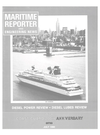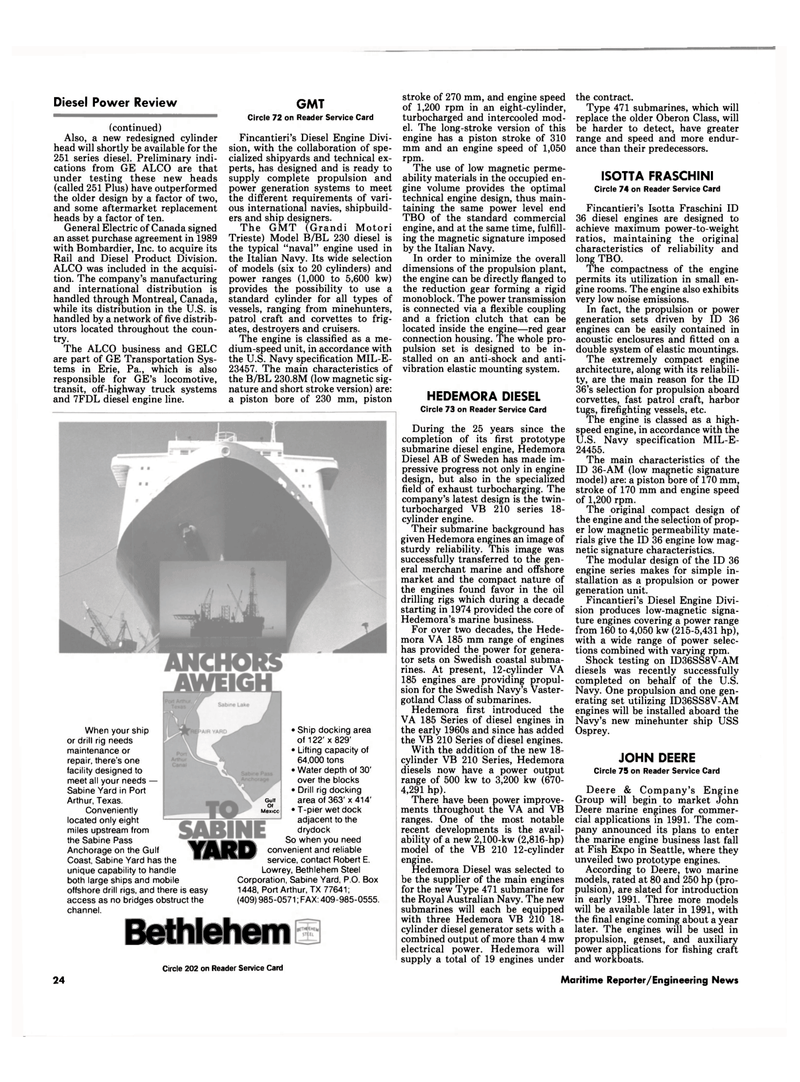
Page 27: of Maritime Reporter Magazine (July 1990)
Read this page in Pdf, Flash or Html5 edition of July 1990 Maritime Reporter Magazine
Diesel Power Review (continued)
Also, a new redesigned cylinder head will shortly be available for the 251 series diesel. Preliminary indi- cations from GE ALCO are that under testing these new heads (called 251 Plus) have outperformed the older design by a factor of two, and some aftermarket replacement heads by a factor of ten.
General Electric of Canada signed an asset purchase agreement in 1989 with Bombardier, Inc. to acquire its
Rail and Diesel Product Division.
ALCO was included in the acquisi- tion. The company's manufacturing and international distribution is handled through Montreal, Canada, while its distribution in the U.S. is handled by a network of five distrib- utors located throughout the coun- try.
The ALCO business and GELC are part of GE Transportation Sys- tems in Erie, Pa., which is also responsible for GE's locomotive, transit, off-highway truck systems and 7FDL diesel engine line.
GMT
Circle 72 on Reader Service Card
Fincantieri's Diesel Engine Divi- sion, with the collaboration of spe- cialized shipyards and technical ex- perts, has designed and is ready to supply complete propulsion and power generation systems to meet the different requirements of vari- ous international navies, shipbuild- ers and ship designers.
The GMT (Grandi Motori
Trieste) Model B/BL 230 diesel is the typical "naval" engine used in the Italian Navy. Its wide selection of models (six to 20 cylinders) and power ranges (1,000 to 5,600 kw) provides the possibility to use a standard cylinder for all types of vessels, ranging from minehunters, patrol craft and corvettes to frig- ates, destroyers and cruisers.
The engine is classified as a me- dium-speed unit, in accordance with the U.S. Navy specification MIL-E- 23457. The main characteristics of the B/BL 230.8M (low magnetic sig- nature and short stroke version) are: a piston bore of 230 mm, piston stroke of 270 mm, and engine speed of 1,200 rpm in an eight-cylinder, turbocharged and intercooled mod- el. The long-stroke version of this engine has a piston stroke of 310 mm and an engine speed of 1,050 rpm.
The use of low magnetic perme- ability materials in the occupied en- gine volume provides the optimal technical engine design, thus main- taining the same power level end
TBO of the standard commercial engine, and at the same time, fulfill- ing the magnetic signature imposed by the Italian Navy.
In order to minimize the overall dimensions of the propulsion plant, the engine can be directly flanged to the reduction gear forming a rigid monoblock. The power transmission is connected via a flexible coupling and a friction clutch that can be located inside the engine—red gear connection housing. The whole pro- pulsion set is designed to be in- stalled on an anti-shock and anti- vibration elastic mounting system.
HEDEMORA DIESEL
Circle 73 on Reader Service Card
During the 25 years since the completion of its first prototype submarine diesel engine, Hedemora
Diesel AB of Sweden has made im- pressive progress not only in engine design, but also in the specialized field of exhaust turbocharging. The company's latest design is the twin- turbocharged VB 210 series 18- cylinder engine.
Their submarine background has given Hedemora engines an image of sturdy reliability. This image was successfully transferred to the gen- eral merchant marine and offshore market and the compact nature of the engines found favor in the oil drilling rigs which during a decade starting in 1974 provided the core of
Hedemora's marine business.
For over two decades, the Hede- mora VA 185 mm range of engines has provided the power for genera- tor sets on Swedish coastal subma- rines. At present, 12-cylinder VA 185 engines are providing propul- sion for the Swedish Navy's Vaster- gotland Class of submarines.
Hedemora first introduced the
VA 185 Series of diesel engines in the early 1960s and since has added the VB 210 Series of diesel engines.
With the addition of the new 18- cylinder VB 210 Series, Hedemora diesels now have a power output range of 500 kw to 3,200 kw (670- 4,291 hp).
There have been power improve- ments throughout the VA and VB ranges. One of the most notable recent developments is the avail- ability of a new 2,100-kw (2,816-hp) model of the VB 210 12-cylinder engine.
Hedemora Diesel was selected to be the supplier of the main engines for the new Type 471 submarine for the Royal Australian Navy. The new submarines will each be equipped with three Hedemora VB 210 18- cylinder diesel generator sets with a combined output of more than 4 mw electrical power. Hedemora will supply a total of 19 engines under the contract.
Type 471 submarines, which will replace the older Oberon Class, will be harder to detect, have greater range and speed and more endur- ance than their predecessors.
ISOTTA FRASCHINI
Circle 74 on Reader Service Card
Fincantieri's Isotta Fraschini ID 36 diesel engines are designed to achieve maximum power-to-weight ratios, maintaining the original characteristics of reliability and long TBO.
The compactness of the engine permits its utilization in small en- gine rooms. The engine also exhibits very low noise emissions.
In fact, the propulsion or power generation sets driven by ID 36 engines can be easily contained in acoustic enclosures and fitted on a double system of elastic mountings.
The extremely compact engine architecture, along with its reliabili- ty, are the main reason for the ID 36's selection for propulsion aboard corvettes, fast patrol craft, harbor tugs, firefighting vessels, etc.
The engine is classed as a high- speed engine, in accordance with the
U.S. Navy specification MIL-E- 24455.
The main characteristics of the
ID 36-AM (low magnetic signature model) are: a piston bore of 170 mm, stroke of 170 mm and engine speed of 1,200 rpm.
The original compact design of the engine and the selection of prop- er low magnetic permeability mate- rials give the ID 36 engine low mag- netic signature characteristics.
The modular design of the ID 36 engine series makes for simple in- stallation as a propulsion or power generation unit.
Fincantieri's Diesel Engine Divi- sion produces low-magnetic signa- ture engines covering a power range from 160 to 4,050 kw (215-5,431 hp), with a wide range of power selec- tions combined with varying rpm.
Shock testing on ID36SS8V-AM diesels was recently successfully completed on behalf of the U.S.
Navy. One propulsion and one gen- erating set utilizing ID36SS8V-AM engines will be installed aboard the
Navy's new minehunter ship USS
Osprey.
JOHN DEERE
Circle 75 on Reader Service Card
Deere & Company's Engine
Group will begin to market John
Deere marine engines for commer- cial applications in 1991. The com- pany announced its plans to enter the marine engine business last fall at Fish Expo in Seattle, where they unveiled two prototype engines.
According to Deere, two marine models, rated at 80 and 250 hp (pro- pulsion), are slated for introduction in early 1991. Three more models will be available later in 1991, with the final engine coming about a year later. The engines will be used in propulsion, genset, and auxiliary power applications for fishing craft and workboats.
Bethlehem
Circle 202 on Reader Service Card
When your ship or drill rig needs maintenance or repair, there's one facility designed to meet all your needs —
Sabine Yard in Port
Arthur, Texas.
Conveniently located only eight miles upstream from the Sabine Pass
Anchorage on the Gulf
Coast, Sabine Yard has the unique capability to handle both large ships and mobile offshore drill rigs, and there is easy access as no bridges obstruct the channel.
Gull
Of
Mexico
YARD • Ship docking area of 122' x 829' • Lifting capacity of 64,000 tons • Water depth of 30' over the blocks • Drill rig docking area of 363' x 414' • T-pier wet dock adjacent to the drydock
So when you need convenient and reliable service, contact Robert E.
Lowrey, Bethlehem Steel
Corporation, Sabine Yard, P.O. Box 1448, Port Arthur, TX 77641; (409) 985-0571; FAX: 409-985-0555. 24 Maritime Reporter/Engineering News

 26
26

 28
28
